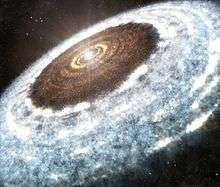V883 Orionis
 The location of V883 Orionis (circled) | |
| Observation data Epoch Equinox | |
|---|---|
| Constellation | Orion |
| Right ascension | 05h 38m 18.1s[1] |
| Declination | −07° 02′ 26″[1] |
| Characteristics | |
| Variable type | FU Ori |
| Astrometry | |
| Distance | 414 ± 7[2] pc |
| Details | |
| Mass | 1.29 ± 0.02[2] M☉ |
| Luminosity (bolometric) | 6[2] L☉ |
| Age | 0.5[2] Myr |
| Other designations | |
V883 Ori, HBC 489 | |
| Database references | |
| SIMBAD | data |
V883 Orionis is a protostar in the constellation of Orion. It is associated with IC 430 (Haro 13A), a peculiar Hα object surveyed by Guillermo Haro in 1952.[3] It is located about 1350 light years (414 parsecs) away,[2] and is associated with the Orion Nebula.[4]
V883 Orionis, like most protostars, is surrounded by a circumstellar disc of dust. The dust has a water snow line, a certain distance where the stellar irradiance from the star is low enough that water can freeze to snow. The water snow line was directly imaged by ALMA, when a stellar outburst increased the amount of insolation and pushed the line out farther.[2]
Gallery
 Artist's impression of the water snow line around V883 Orionis, detected with ALMA
Artist's impression of the water snow line around V883 Orionis, detected with ALMA IC 429 and IC 430 next to the star 49 Ori
IC 429 and IC 430 next to the star 49 Ori
References
- 1 2 "V883 Ori". SIMBAD. Centre de données astronomiques de Strasbourg. Retrieved 20 February 2017.
- 1 2 3 4 5 6 Cieza, Lucas A.; et al. (2016). "Imaging the water snow-line during a protostellar outburst". Nature. 535 (7611): 258–261. arXiv:1607.03757. Bibcode:2016Natur.535..258C. doi:10.1038/nature18612.
- ↑ Allen, D. A.; Strom, K. M.; Grasdalen, G. L.; Strom, S. E.; Merrill, K. M. (1975). "Haro 13a: A Luminous, Heavily Obscured Star in Orion?". Monthly Notices of the Royal Astronomical Society. 173: 47P. Bibcode:1975MNRAS.173P..47A. doi:10.1093/mnras/173.1.47P.
- ↑ "The star V883 Orionis in the constellation of Orion'". ESO.
This article is issued from
Wikipedia.
The text is licensed under Creative Commons - Attribution - Sharealike.
Additional terms may apply for the media files.